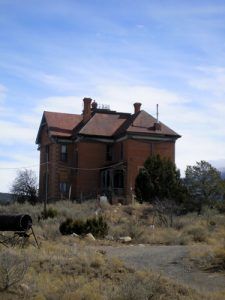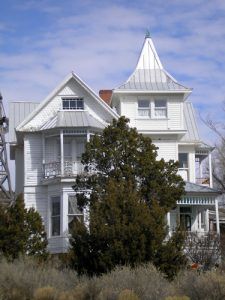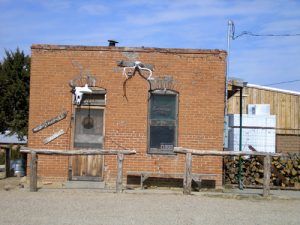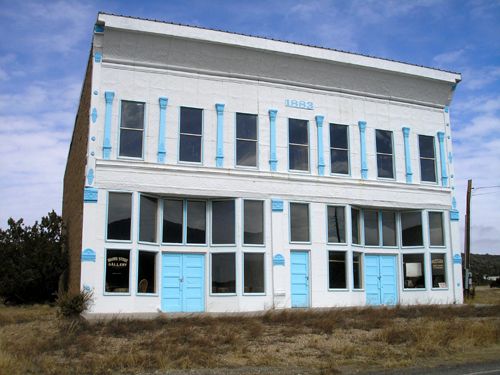
The 1893 Brown Store building, which at various times held a school, a dance hall, and offices, by Kathy Alexander.
Before White Oaks became known as the liveliest town in New Mexico Territory, the area was first roamed by the Piros Indians before the fierce Apache forced them out. Though the region is arid and dotted with lava rock, the Indians found it abundant with game and made it one of their hunting grounds.
The first Europeans to travel into the area were members of Don Juan de Oñate’s expedition in the late 1500s, who called the land Malpais, a term loosely meaning “badland.”
Though sparsely populated for centuries, that all changed when prospectors found gold in the Jicarilla Mountains.
Initially discovered by a man named John Wilson, allegedly an escapee from a Texas prison, Wilson shared his find with two friends, Jack Winters and Harry Baxter. Though Winters and Baxter were ecstatic, Wilson had no interest in gold and soon moved on, leaving his find to his friends.
Word soon spread of the gold find, and within a year, a new mining camp filled with tents was born. The camp was called White Oaks after a small stream lined with white oak trees near the community. In 1880, a post office was established, and permanent buildings began replacing tents and ramshackle shacks. The boomtown quickly grew, supporting some 50 different businesses, including four newspapers, two hotels, three churches, a sawmill, a bank, an opera house, livery stables, and a number of the ever-present saloons and gambling houses.
In the meantime, prospectors Winters and Baxter staked two claims, the Homestake Mine and the South Homestake Mine. The mountain where the gold was found was called Baxter Mountain. Eventually, the two gold miners sold their claims for $300,000 each.
Like other booming mining camps of the day, White Oaks is filled with legends and lore, including that of a “lady” by the name of Belle La Mar, who was more familiarly known as “Madam Varnish.” Hailing from Missouri, La Mar, made her way to the New Mexico mining camp that was “hungry” for the sight of women. She soon established the Little Casino Saloon, where she dealt faro, roulette, and poker. Quickly taking the gold of the many miners in the area, she earned her nickname when the miners said she was as “slick as varnish.” Though many lost their hard-earned gold at the Little Casino, it was the reigning saloon in town. Other popular stops for the miners were the Star Saloon and Opera House.
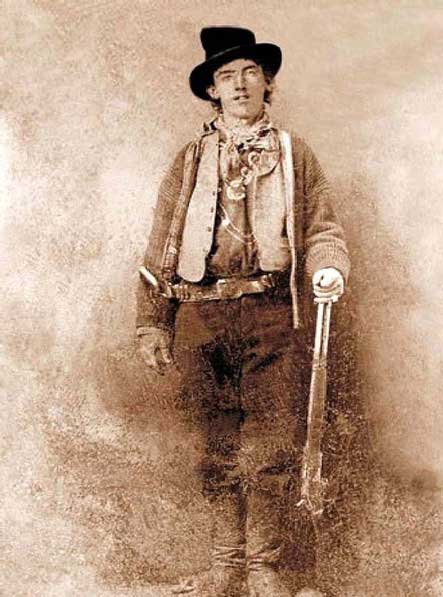
This photo taken of Billy the Kid shows him as left-handed. However, it was a tintype, which created a mirror image. He was actually right-handed.
During White Oaks’ early days, the town was frequented by the infamous Billy the Kid. Billy’s main stomping grounds were in Lincoln, some 40 miles east of White Oaks, but the Kid was known to hang with other roughnecks in the thriving mining camp filled with saloons, gambling parlors, and prostitutes.
After the Lincoln County War was over, Billy and his gang of “Rustlers” often targeted cattle in the White Oaks vicinity. After one attempted theft, the citizens of White Oaks rose in protest, gathered up a posse, and went after the gang. Though they caught up with the outlaws and a gunfight ensued, the thieves managed to escape.
Although White Oaks citizens had made it known that they wouldn’t tolerate the likes of Billy the Kid and his cohorts, three of the outlaws, including Billy, Dave Rudabaugh, and Billy Wilson, returned to White Oaks the very next evening. Flaunting themselves, Rudabaugh took a shot at Deputy Sheriff James Redman just for fun.
The shot missed, and Redman ran for cover. He was soon joined by a crowd of over 30 men who were determined to run the outlaws out of town, which they did. The posse then tracked the rustlers to a ranch some 40 miles distant, where yet another gunfight ensued, resulting in the death of an innocent man. Once again, the outlaws escaped, and soon a reward was placed on Billy the Kid’s head.
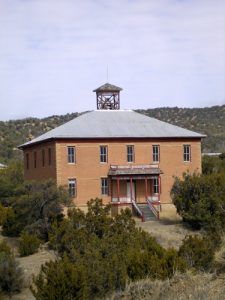
The 1895 White Oaks School Building. It closed in 1947 but has since been used as a local meeting place. Photo by Kathy Alexander.
The settlement’s early, rapid growth soon demanded a stage line linking White Oaks to Fort Stanton, San Antonio, New Mexico, Roswell, and other destinations.
By 1885, most seedier elements had left White Oaks, and the town settled into a community of law-abiding citizens. Tragedy struck White Oaks in July 1891 when a fire erupted at the South Homestake Mine, claiming the lives of two miners. However, mining continued, and for the next five years, both Homestake mines prospered.
By 1890, the town’s population had grown to more than 2,000, but at about the same time, the Homestake Mines were about to peter out. However, White Oaks was saved when another mine, called the “Old Abe,” was developed, which employed large numbers of men and was immensely profitable. The town’s population soon reached about 2,500.
In 1893, Watt Hoyle, one of the owners of the Old Abe Mine, built a two-story Victorian brick home for his fiancée. However, when the young lady wrote him that she was not coming to White Oaks, the mansion, with its stately gables and sharply-pitched roof, became known as “Hoyle’s folly.” He never finished the inside of the home, and later, legends would abound that he was so heartsick that he leaped to his death. However, that was not the case. Hoyle actually lived in the house with his older brother and his wife. Hoyle reportedly sold the home in the 1890s and moved to Denver.
In March 1895, tragedy struck again when a fire in the Old Abe Mine took the lives of eight men. However, the mine continued to operate until shortly after the turn of the century, when the deposits became less profitable. When the mine developed a problem with the timbers in the shaft, it was finally shut down.
Of the many mining operations, the Old Abe Mine was the largest, employing about 40 workers and yielding between 45 and 50 tons of gold ore per day. Other operations included the Robert E. Lee, the Smuggler, the Rita, Lady Godiva, Little Mack, Silver Cliff, Miners Cabin, and others. All told, the mines of White Oaks yielded about $20 million in gold and other minerals.
With its precious minerals depleted and the railroad having bypassed the settlement in favor of nearby Carrizozo, the town declined dramatically. By 1910, White Oaks had only about 200 residents. Though significantly reduced in size, the town continued as a small trading center until the 1950s.
Today, White Oaks is home to just a few remaining residents. However, many of its historic buildings still stand, including Brown’s Store, the Hoyle House, the 1895 brick schoolhouse, and numerous old residences. Several buildings were undergoing renovation during our visit in 2008.
White Oaks is 12 miles northeast of Carrizozo, New Mexico.
While in the area, an unpaved forest road leads northwest out of White Oaks, taking the visitor on a circuitous route to the ghost towns of Jicarilla and Ancho. Though unpaved, the road is well-maintained and can be traveled in almost any vehicle.
Contact Information:
White Oaks, New Mexico
974 White Oaks Road
White Oaks, New Mexico
©Kathy Alexander/Legends of America, updated November 2025.
Also See:
Ghost Towns & Mining Camps of New Mexico
New Mexico – The Land of Enchantment
See Sources.

